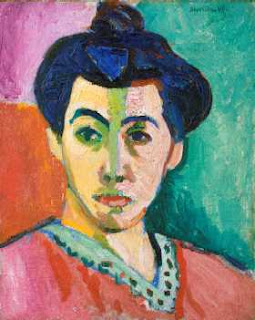Fauvism. Movement in early 20th-century painting based on the use of intensely vivid, non-naturalistic colours; centred on a group of French artists who worked together from about 1905 to 1907, it was the first of the major avant-garde movements in European art in the period of unprecedented experimentation between the turn of the century and the First World War. The dominant figure of the Fauvist group was Henri Matisse; he used vividly contrasting colours as early as 1899 and came to realize the potential of colour freed from its traditional descriptive role when he painted with Signac in the bright light of Saint Tropez in the summer of 1904 and with Derain at Collioure in the summer of 1905. The Fauves first exhibited together at the Salon d'Automne of 1905 and their name was given to them by the critic Louis Vauxcelles (1870–1943), who pointed to a Renaissance-like sculpture in the middle of the same gallery and exclaimed: ‘Donatello au milieu des fauves!’ (Donatello among the wild beasts). The remark was printed in the daily newspaper Gil Blas on 17 October and the name immediately caught on. Predictably, the Fauvist pictures came in for a good deal of mockery and abuse; the critic Camille Mauclair (1872–1945), for example, wrote that ‘A pot of paint has been flung in the face of the public.’ However, there were also some sympathetic reviews, and Gertrude and Leo Stein bought Matisse's Woman with a Hat (priv. coll.), the picture that was attracting the worst abuse. This greatly helped to restore Matisse's battered morale and marked the beginning of a dramatic rise in his fortunes.
Among the artists who exhibited with Matisse at the 1905 Salon d'Automne were Derain, Friesz, Marquet, Rouault, Vlaminck, and the Dutch-born van Dongen. Later they were joined by Dufy (1906) and Braque (1907). All of these were a few years younger than Matisse (mainly in their twenties, whereas he was 35). Lesser figures associated with the group included Jean Puy (1876–1960) and Louis Valtat (1869–1952). These artists were influenced in varying degrees by Cézanne, van Gogh, Gauguin, and the Neo-Impressionists. Their most characteristic subject was landscape and the outstanding feature of their work was extreme intensity of colour, often used arbitrarily for emotional and decorative effect. Apart from this, they had no programme in common.
As a concerted movement Fauvism reached its peak in the Salon d'Automne of 1905 and the Salon des Indépendants of 1906, and by 1907 the members of the group were drifting apart. For most of them Fauvism was a temporary phase through which they passed in the development of widely different styles (Valtat was an exception, for he continued to explore the use of pure colour throughout his life), and their work never again displayed such similarity. Although short-lived, however, Fauvism was highly influential, for example on German Expressionism and the work of the Scottish Colourists.
IAN CHILVERS. "Fauvism." The Oxford Dictionary of Art. 2004. Retrieved June 06, 2012 from Encyclopedia.com: http://www.encyclopedia.com/doc/1O2-Fauvism.html
| Henri Matisse | |
|---|---|
Photo of Henri Matisse by Carl Van Vechten, 1933 |
|
| Birth name | Henri-Émile-Benoît Matisse |
| Born | 31 December 1869 Le Cateau-Cambrésis, Nord |
| Died | 3 November 1954 (aged 84) Nice, Alpes-Maritimes |
| Nationality | French |
| Field | Painting, printmaking, sculpture, drawing, collage |
| Training | Académie Julian, William-Adolphe Bouguereau, Gustave Moreau |
| Movement | Fauvism, modernism, impressionism |
| Works |
Woman with a Hat (Madame Matisse), 1905 in museums: |
| Patrons | Gertrude Stein, Etta Cone, Claribel Cone, Michael and Sarah Stein, Albert C. Barnes |
| Influenced by | John Peter Russell, Paul Cézanne, Paul Gauguin, Vincent van Gogh, Paul Signac |
| Influenced | Hans Hofmann, David Hockney, Tom Wesselmann |
Henri-Émile-Benoît Matisse: (31 December 1869 – 3 November 1954) was a French artist, known for his use of colour and his fluid and original draughtsmanship. He was a draughtsman, printmaker, and sculptor, but is known primarily as a painter. Matisse is commonly regarded, along with Picasso and Marcel Duchamp, as one of the three artists who helped to define the revolutionary developments in the plastic arts in the opening decades of the 20th century, responsible for significant developments in painting and sculpture. Although he was initially labelled a Fauve (wild beast), by the 1920s he was increasingly hailed as an upholder of the classical tradition in French painting. His mastery of the expressive language of colour and drawing, displayed in a body of work spanning over a half-century, won him recognition as a leading figure in modern art. While most widely recognized for his paintings, Matisse actively worked in a variety of media throughout his career.



Hiç yorum yok:
Yorum Gönder